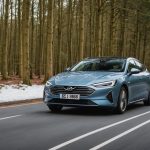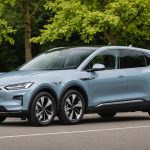Unlocking Range Potential: Innovative Aerodynamic Strategies for British Electric Vehicles
As the world transitions towards more sustainable and environmentally friendly transportation, the focus on electric vehicles (EVs) has never been more intense. One of the critical factors in enhancing the appeal and practicality of EVs is improving their driving range, and aerodynamics plays a pivotal role in this endeavor. In this article, we will delve into the innovative aerodynamic strategies being employed by British and other global manufacturers to unlock the full range potential of electric vehicles.
The Importance of Aerodynamics in Electric Vehicles
Aerodynamics is not just a matter of aesthetics; it significantly impacts the efficiency and range of electric vehicles. By reducing air resistance, EVs can travel farther on a single charge, which is crucial for overcoming range anxiety and making EVs more viable for long-distance travel.
Have you seen this : Optimize your british sports car”s performance: the ultimate guide to achieving ideal ride height for enhanced aerodynamics
How Aerodynamics Affects Range
- Energy Consumption: Aerodynamic design helps reduce the energy consumed by the vehicle, as less power is needed to overcome air resistance. This directly translates to extended driving ranges.
- Battery Life: Efficient aerodynamics can prolong the life of the battery by reducing the load on the powertrain, thereby ensuring that the vehicle can maintain its performance over time.
- Charging Times: While fast charging infrastructure is advancing, any reduction in energy consumption due to better aerodynamics can also reduce the time spent at charging stations.
Innovative Aerodynamic Designs
Several British and international manufacturers are at the forefront of innovative aerodynamic design for electric vehicles.
Volvo FH Aero Electric: A Benchmark in Trucking Aerodynamics
Volvo Trucks has set a new standard with the introduction of the Volvo FH Aero Electric. This vehicle boasts a redesigned aerodynamic truck cab that has been elongated and rounded to reduce drag significantly. Here are some key features:
Topic to read : Maximize your racing edge: pro strategies for optimizing gear ratios in british racing cars
- Streamlined Cab Design: The extended cab by 24 centimeters and the sealing of gaps and split lines on the exterior reduce air resistance, making the truck more efficient, especially in high crosswinds[1].
- Camera Monitoring System (CMS): Replacing traditional mirrors with high-tech camera arms reduces air drag while providing improved visibility for drivers[1].
- Optimized Powertrains: The FH Aero Electric offers various powertrain options, including electric, diesel, and gas, all optimized for reduced energy consumption and emissions[1].
BMW’s Aeroacoustics and Electric Drive Centre
BMW has taken a significant step in advancing aerodynamic research with the inauguration of its Aeroacoustics and Electric Drive Centre (AEC) in Munich. This facility features the world’s largest and quietest vertical acoustic wind tunnel, enabling precise measurement of aerodynamic noise.
- Advanced Wind Tunnel: The wind tunnel operates at a background noise level of 54.3 dB(A) at 140 km/h, allowing for the precise assessment of aerodynamic sounds generated by vehicles. It can accommodate large models and features advanced measurement technologies like a 216-microphone acoustic camera and laser vibrometry system[2][4].
- Realistic Simulations: The wind tunnel is designed as an acoustic semi-free-field space, minimizing sound reflections and providing a realistic simulation of on-road conditions. This setup is crucial for optimizing vehicle acoustics and aerodynamics[2][4].
British EV Start-ups: Radical Approaches to Affordability and Efficiency
A new British EV start-up is working on a pioneering electric vehicle aimed at delivering a 160-mile range for just £15,000, significantly undercutting most current electric cars on the market.
Minimalist Design and Cost-Effective Production
- Simplified Components: The company is focusing on minimalist design, cutting-edge powertrain components, and cost-effective production methods to strip away unnecessary complexity and reduce costs without compromising safety or reliability[3].
- Aerodynamic Optimization: Radical approaches to materials, aerodynamics, and component sourcing are being taken to ensure the vehicle is as efficient as possible. This includes optimizing the vehicle’s shape to reduce air resistance and enhance driving range[3].
Jaguar’s Type 00 Concept: A Glimpse into Future EV Design
Jaguar’s Type 00 concept car embodies the company’s future technical direction, particularly in terms of aerodynamics and EV engineering.
Dedicated EV Platform and Aero-Optimized Shape
- Jaguar Electric Architecture (JEA): The Type 00 is built on a bespoke EV platform that maximizes the advantages of electric powertrains. This includes a “cab-forward” design and an elongated wheelbase, which would not be possible with an internal combustion platform[5].
- Flush Aerodynamics: The Type 00 features sleek, flush surfaces, retractable door handles, and hidden front air intakes to optimize airflow. The dramatic low-slung proportions and fastback profile help the vehicle slice through the air efficiently, minimizing drag[5].
Practical Insights and Actionable Advice
For those interested in maximizing the range of their electric vehicles, here are some practical insights and actionable advice:
Maintain Your Vehicle
- Regularly check and maintain your vehicle’s tires, as properly inflated tires can significantly reduce rolling resistance and improve aerodynamics.
- Ensure that all exterior components, such as mirrors and spoilers, are securely attached and aligned to minimize air drag.
Optimize Your Driving
- Regenerative Braking: Use regenerative braking wisely to capture kinetic energy and convert it back into electrical energy, extending your vehicle’s range.
- Smooth Acceleration: Avoid sudden accelerations and hard braking, as these can increase energy consumption. Instead, drive smoothly and maintain a consistent speed.
Choose the Right Vehicle
- Aerodynamic Design: When purchasing an EV, look for models with aerodynamically optimized designs. These vehicles are engineered to reduce air resistance, thereby extending their driving range.
- Battery and Powertrain: Opt for vehicles with high-efficiency batteries and powertrains. For example, the 800V electrical architecture used by Jaguar and others allows for faster charging and more efficient energy use[5].
Comparative Analysis of Aerodynamic Features
Here is a comparative table highlighting some of the innovative aerodynamic features of the vehicles mentioned:
| Vehicle Model | Aerodynamic Features | Range per Charge | Charging Infrastructure |
|---|---|---|---|
| Volvo FH Aero Electric | Redesigned aerodynamic cab, CMS, optimized powertrains | Up to 300 km | Fast charging support |
| BMW EVs (using AEC) | Advanced wind tunnel testing, acoustic semi-free-field space | Varies by model | Fast charging support |
| British £15k EV Start-up | Minimalist design, optimized materials and component sourcing | Up to 160 miles | Standard charging |
| Jaguar Type 00 | Dedicated EV platform, flush aerodynamics, retractable door handles | N/A (concept) | 800V fast charging |
Innovative aerodynamic strategies are at the heart of unlocking the full range potential of electric vehicles. From Volvo’s streamlined truck cabs to BMW’s advanced wind tunnel testing and Jaguar’s dedicated EV platforms, these approaches not only enhance the efficiency and range of EVs but also contribute to a more sustainable transportation future.
As the industry continues to evolve, we can expect even more radical and effective solutions to emerge. For consumers, understanding and leveraging these innovations can make a significant difference in their daily driving experiences, reducing energy consumption, emissions, and the overall cost of ownership.
In the long term, these advancements will be crucial in transitioning away from fossil fuels and towards a more sustainable transportation infrastructure, making electric vehicles an increasingly viable option for both personal and commercial use.











